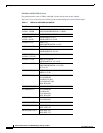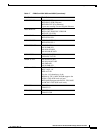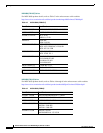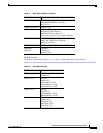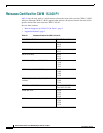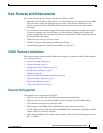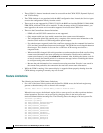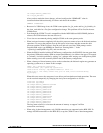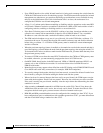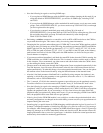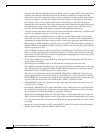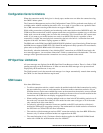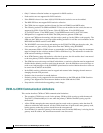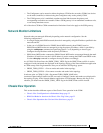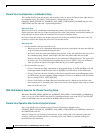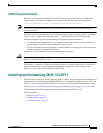
26
Release Notes for the Cisco WAN Manager, Release 15.3.00 P1
OL-11190-01, Rev. C0
CWM Feature Limitations
• If an ATM IP interface (also called In-band interface) is being used to manage the switch from the
CWM, the CWM cannot receive all node bring-up traps. The ATM connections required for in-band
management can take time to get routed on node bring-up and therefore are not available for trap
delivery at the initialization time. If this initialization time is an issue, the workaround is to
configure the CWM for out-of-band management.
• Allow a 2- to 3-minute period between enabling or disabling statistics operations on the same BPX
or IGX node. Whenever statistics are enabled or disabled on a BPX or IGX node and the switch is
configuring statistics, enabling or disabling statistics a second time fails.
• If the Start Collection process on the SCM GUI is taking a long time, investigate whether or not
collection was started with an unreachable in-band or out-of-band IP address. Use a reachable
IP address to start collection with a reachable IP address, either in band or out of band.
• The SSM statistics database can go out of sync with node_ids on the CWM after a coldstart –F is
executed on the server. To ensure that the node IDs remain consistent, stop and disable collection
before doing a coldstart –F. A CWM-to-CWM gateway must be enabled to ensure uninterrupted
statistics collection.
• When the persistent topology feature is enabled, to decommission a node in the network and take it
out of the topology you must delete the node from the persistent topology data using the switch CLI.
To decommission a node or to delete a trunk from the PNNI network, you must delete the entry from
the persistent gateway nodes.
• To ensure all CWM servers have the same XPVC Preferred data, the CWM-to-CWM gateway must
be enabled; otherwise, you must manually propagate the data to all CWM servers.
• On MGX PXM1-based feeders in the BPX network, VISM or VISM-PR terminated XPVCs can
connect only to the AUSM service module. No such restriction exists for PXM1E-based or
PXM45-based nodes.
• Manual node resync may appear to have failed due to the GUI timing out for PXM45/PXM1E-based
Cisco MGX nodes with many connections (for example, 400K DAX endpoints).
• To correctly manage feeder nodes after they have been moved, you must first delete all trunks from
the old node by using the CLI before adding the feeder back onto the system.
• When a back card is removed because the front card is not provisioned, the CWM reports a major
alarm with the description “Back Card; not present.” However, the switch may not show an alarm.
If the card is actually not provisioned, manually clear the major alarm after determining the alarm
condition is not real.
• After executing a clrsmcnf command for AXSM from the switch CLI, Chassis View shows the
AXSM front card once the card is active, but no back card is found. To ensure that Chassis View
recognizes the back card again, you must execute a first level manual node resync.
• RPM-PR and RPM ports/subinterfaces must be configured with a number less than 32767. If you
have configured any ports or subinterfaces with a number greater than 32767, you must delete them
and then re-add them using a number less than 32767.



